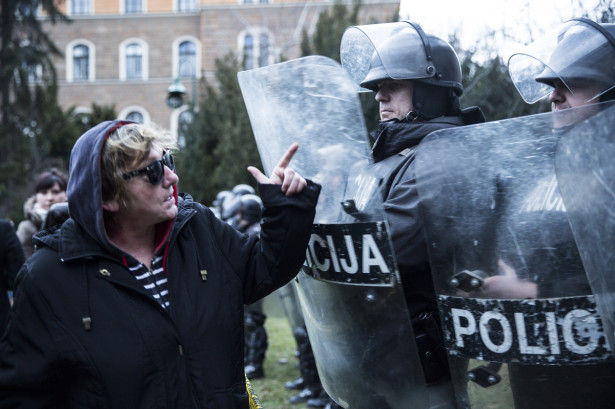
“We want to show our politicians what real democracy is,” said one young Bosnian protester in the streets of Sarajevo. “We’re building democracy from scratch, like the Greeks did,” commented another protester, who is a retiree. It’s a rainy day in Sarajevo, but the Bosnian citizens are persistent. If their politicians keep failing, the citizens will have to change the country for the better.
Since the outburst of violent mass protests in Bosnia and Herzegovina in the first week of February, protesters have organized plenums — which is a Latin word meaning an assembly of all the members of a group or committee — in 12 cities throughout the country. In an extraordinary move, they have turned the violence of the first days of social unrest into a serious attempt to build and strengthen the Bosnian democracy. Bosnians tell their leaders they cannot continue like this. They are angry with their political elites who are corrupt, have halted economic development and have kept the country ethnically divided for the past 20 years.
Over the years Bosnians have repeatedly protested. Factory workers have been staging demonstrations over unpaid salaries, and war veterans have been protesting because of pension cuts. But never in post-war Bosnia have citizens been so fed up.
Countrywide mass protests broke out on Feb. 7, after a wave of protests which turned violent in Tuzla, an industrial city in the northeast of the country. Thousands of unemployed and underpaid factory workers took to the streets a few days earlier over the privatization and closing down of a number of former state-owned factories. Since the start of the privatization process in the 2000s, corrupt politicians and ruling parties have sold public enterprises, such as Tuzla’s Dita detergent factory, to themselves or to their allies for a small fraction of their actual worth.
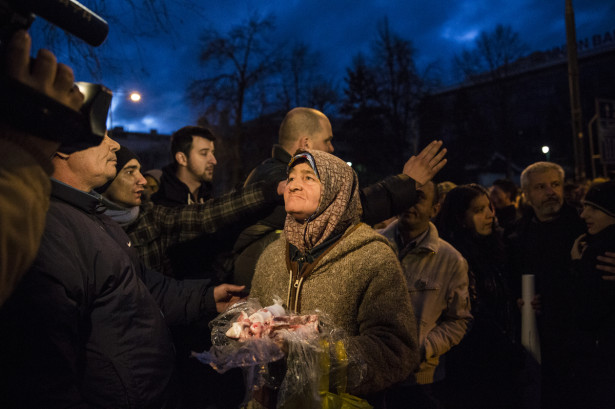
The protests rapidly spread throughout the country, and turned into an explosion of anger and rage. Protesters set government buildings on fire in several cities and riot police responded with tear gas and water canons. The protests evolved to be about everything that’s wrong in Bosnia: low pensions, corruption, economic decay, political stagnation and high unemployment — which stands at around 45 percent nationally, and is even higher among youth.
“Before there was usually a very flat reaction of the citizens, they were following what was happening with apathy. Now the anger has come out,” said Srdan Dizdarevic, director of the Bosnian Helsinki Committee. “It’s a sign of discontent with how the politicians have been leading this country for years — taking care of themselves, being corrupt and not taking care of the citizens.”
According to Human Rights Watch, the police used excessive force against the protesters on the streets and around 30 youths who were arrested. The group’s recent report urged the Bosnian authorities to investigate the police violence.
Meanwhile, the leading politicians called the protesters “hooligans” and accused them of terrorism while ignoring the social unrest and their demands. Four local governments resigned, one in Tuzla, but the government on state level saw no reason to step down. Instead, parliament focused on addressing the needs of the police, equipping them with better equipment including rubber bullets, in preparation for a possible new wave of violence.
Nevertheless, many protesters say they don’t want to create any more violence. Every day since Feb. 7, the demonstrations have continued peacefully. While the number of protesters seems to have declined over the past two weeks, a few thousand people consistently take to the streets every day. The level of support for the protests is most visible at the plenums.
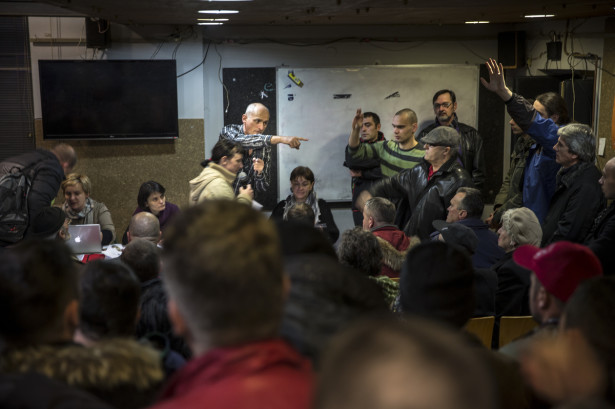
The first plenum, which was to take place on Feb. 12 in Sarajevo, had to be postponed because too many people showed up to fit in the venue where it was to be held. Almost every day since, around a thousand concerned citizens have participated in the plenum, filling every seat at the Dom Mladih, a huge concert venue. There are a few voluntary moderators, but no leaders. Everyone is invited to take the stage for two minutes to express what is on their mind, before handing the microphone to the next person. Retirees express frustration with their low incomes, students speak about the problems with corruption at their universities, the unemployed decry how difficult it is to find a job because they don’t have the right connections.
“We are willing to work on our future, and we are asking our politicians to do the same. Just stand up and do your job,” said Ines Tanovic, one of the moderators. “It is amazing to see so many people come to the plenum. People who have been silent for two decades have found a place to speak out and help build this country.”
Besides an opportunity for the citizens to express discontent, the plenums are therapeutic for many who lived through the war and have since been living in impoverished conditions. “It is difficult sometimes to get people to understand they only have two minutes of time to speak,” explained Tanovic. “There is so much pain.”
Together, the citizens present at the plenum worked to compile a list of demands for the regional government in the Bosnian capital, which officially resigned after the early violent protests. Some representatives, however, are still working. The list calls for a new government made up of people who are not a member of any political party, elected with support from the plenum. The plenum also demands cuts in the salaries of government officials and the abolition of the “white bread” policy, whereby ministers receive up to a year’s salary after their terms end. The plenum also demands an independent committee be set up to investigate the violence that occurred on Feb. 7, especially the force used by the police on protesters.
The Sarajevo government accepted all the plenum demands on Feb. 24. It is unclear if local governments will be able to implement the demands, however, without changes on the national level. Participants hope these plenums will be able to turn into a constructive and relevant avenue to change and create social policy. Representatives of plenums in different cities are already meeting each other to talk about changes on the state level.
There is still a long way to go. On a national level political elites are not yet willing to listen to the protesters and plenums. They would rather wait for the upcoming elections, planned for October this year. Few believe that change will take place during elections, in part because there is no good organized opposition to the current political leadership.
Regardless, the forming of plenums has been widely praised. As Tim Judah wrote in The Economist, “If the plenums take root, if new leaders emerge and if they focus on realistic demands, something might really change.”
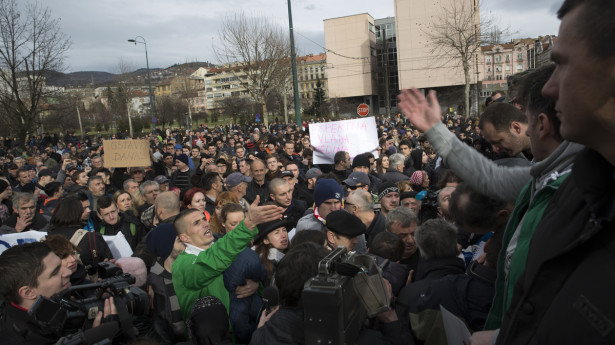
The protests and plenums are bigger in the Bosniak-Croat Federation, one of the two Bosnian entities that were formed after the Dayton agreement, which ended the Bosnian War in 1995. Typically, a couple thousand Bosniaks and Croats take to the streets. In the other entity, the Bosnian Serb Republic protests were small in the beginning; but recently, a growing number of citizens — currently no more than a couple hundred — have been protesting in the de facto capital Banja Luka.
This raises an important question in Bosnia, which has been divided since the devastating ethnic civil war of the 1990s: Are these protests multi-ethnic?
“People finally began seeing through those ethnic divisions,” said human rights activist Emir Hodzic. “Initially, there were a lot of ethnic tensions. Citizens are fed up with that. Now they simply say: ‘Feed us, give us jobs and stop steeling from us.'”
Zoran Markovic, a Bosnian Serb who lived in besieged Sarajevo throughout the war, agrees. “We should know better now. Nationalism is what started the war in the first place,” he said, with a sigh. “I think we understand that much better than our politicians.”
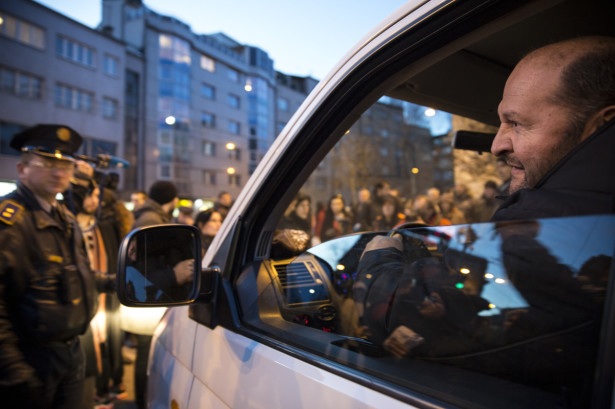
Since the end of the war, Bosnian politics has continued to be strongly divided along ethnic lines, with parties being either Bosniak, Croat or Serb. The peer pressure to vote for your own ethnic party remains strong. But that too is changing, said Markovic. “The nationalistic card is a dying card.”
From the start, the Bosnian uprising has been dubbed by many a Bosnian Spring. Whether this proverbial spring will bloom remains to be seen. The plenums are a constructive and nonviolent beginning, but Bosnia and Herzegovina has deep-rooted problems. Change will not come overnight, said Ines Tanovic. “It’s not always easy to explain to people this is going to be a long process. You cannot change 20 years in two days.”
Still, the desire to keep the movement peaceful remains strong, especially in the country that saw so much violence in the recent past. “At the start of every plenum we call for peaceful protests,” explained Tanovic. “We don’t want more violence. We repeat it constantly, like a mantra. Then [on Feb. 7] we articulated our rage. Now we need to articulate what we want and how.”
